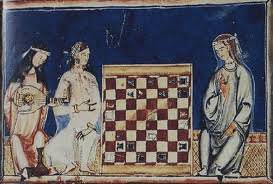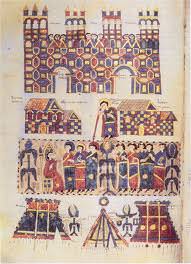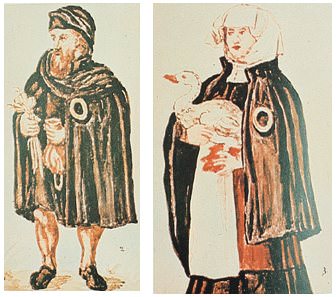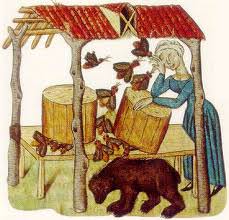Jewish Communal Organisation in Sixteenth-Century Polish Towns
Therefore, this essay will deal not only with the structures of Jewish communal organisation proper, but also with the question of its emergence and development in the context of its non-Jewish environment.
Towards a History of Tolerance: Christian Attitudes to Jews and Muslims in the Middle Ages
The sometimes benign, often neutral or mildly hostile, occasionally horrifically violent history of inter-faith relations from the time of the First Crusade in the mid-twelfth century through to the end of the fifteenth century forms the backdrop to much of what I have to say
The art of medicine: Midwives and obstetric catastrophe: retrieving the past
For the historian, however, and for any healer with an eye for the human dimensions of medicine, the story has just begun. For Floreta is, in fact, the first known European midwife to be put on trial for the death of a mother in childbirth. Indeed, she is charged not with simple medical negligence, but with premeditated murder.
The Urban Structure of the Jewish Quarter of Girona
The studies that have been carried out to date on the tenth and eleventh-century Jewish community are rather few, in contrast to research done on the community in the twelfth century and thereafter, where documentary and archaeological sources abound.
Bodleian Libraries Cairo Genizah collection now available online
From the store room to the web: Bodleian launches website featuring its 25,000 Cairo Genizah fragments
Purim, Liminality, and Communitas
Elaborate pageants, grotesque masks, drunken revelry, noisemaking, buffoonery, burning of effigies, costume parades, feasts with special delicacies, and every manner of carousing and merrymaking have characterized Purim since rabbinic times
The German and Non-German in Yiddish
Today, scholars of various backgrounds dispute the amount of influence German has had on the development of the Yiddish language. While some scholars claim that German has had minimal influence on Yiddish, others say it is the core resource of the language.
Conversion, Sex, and Segregation: Jews and Christians in Medieval Spain
From the late eleventh century to the end of the fifteenth, significant populations of Jews and Muslims lived under Christian domination in the lands we now call Spain. Their coexistence was not easy, for each of the three religious communities felt at risk, both physically and spiritually, from the others
The legal status of religious minorities in the medieval Mediterranean world: a comparative study
From Baghdad to Barcelona, Jews, Christians and Muslims rubbed shoulders in streets and in marketplaces, shared meals, undertook joint economic ventures, traveled together, etc.
Jewish Magic in a Christian World
Medieval Europe, it can be said, had quite an obsession with magic. Whether they resorted to magical practices to relieve their fears, or had an intense fear of being surrounded by magicians, there is no shortage of evidence documenting the belief in magic during the Middle Ages.
Reading Medieval Religious Disputation: The 1240 “Debate” Between Rabbi Yehiel of Paris and Friar Nicholas Donin
This dissertation takes as its subject the Latin and Hebrew accounts of a much-studied event: the Jewish-Christian Disputation of 1240.
Reconquista and convivencia: Post-conquest Valencia during the Reign of Jaime I, el Conquistador: Interaction between Christians and Muslims (1238-1276)
This study will focus on just one aspect of the transition from Muslim kingdom to medieval Christian state. In 1238, Ciudad de Valencia, the most important urban center in the Muslim kingdom of Valencia would fall to Jaime I, el conquistador, king of Christian Aragon and Catalonia, opening up a vast region to Christian influence.
Public can now walk the York Jewish History Trail
The York Jewish History Trail was launched on Friday, giving the public the chance to explore hundreds of years of Jewish history in England.
Medieval Responsa Literature on Niddah: Perpetuations of Notions of Tumah
In Jewish religious practice, the menstruating woman is referred to as the niddah. Until the destruction of the First and Second Temples in 560 B.C.E. and 70 C.E., the niddah was restricted in two ways: she was barred from Temple worship and by extension kept apart from all foodstuffs and vessels that were used for Temple worship; and sexual intercourse with her was forbidden
On the Language of Conversion: Visigothic Spain Revisited
In fifth-century Spain, the Visigoth conquerors – Christians and Arians – had to live with the native Hispani, who were Roman by culture and law and Catholic by faith.
Fossils as Drugs: pharmaceutical palaeontology
The present paper surveys the medicinal applications of a number of fossils which were well known in classical, mediaeval and renaissance times….
Medieval Jewish manuscripts discovered in Afghanistan
Over 150 medieval Jewish documents have been discovered in Afghanistan. The works were found, purportedly by shepherds looking for sheep, in the mountains of Samangan province, which lies along the Silk Road trade route.
Wayward Women: Representations of Mobile Jewish Businesswomen in Medieval Northern Europe
This thesis focuses on representations of Jewish female economic travel, which were frequently depicted even though traditional Rabbinic Judaism dictated travel as a distinctly male activity.
Hanukkah in the Middle Ages
Hanukkah, also known as the Festival of Lights, is an eight-day Jewish holiday commemorating the rededication of the Temple of Jerusalem by Judah Maccabee and his followers after the Maccabean Revolt against Greek rule around 160 BC.
Greeks in Early Medieval Barcelona?
The aim of this article is to draw attention to a group of persenal names which occurs almost exclusively in the city of Barcelona in tilese decades around the year 1000, which may throw some additional llght on the range of externa1 cgntacts. The name in question is that of Greco.
Culture in the Time of Tolerance: Al-Andalus as a Model for Our Time
It existed in any number of different political configurations over nearly eight hundred years, and it was and has been called many names, all of them imprecise for different reasons: al-Andalus in Arabic, ha-Sefarad in Hebrew; the names of a half-dozen different cities when they were at its center; Castile at other moments.
Natural Qualifications of a Medieval Poet According to Moshe Ibn Ezra
The most important attainment of the Arabs, in Ibn Ezra’s opinion, is the distinction they achieved in the field of rhetoric.
Traditional healing with animals (zootherapy): medieval to present-day Levantine practice
Since ancient times animals and products derived from different organs of their bodies have constituted part of the inventory of medicinal substances used in various cultures; such uses still exist in ethnic folk medicine.
The Order of Lighting the Hanukkah Candles: The Evolution of a Custom and the Influence of the Publication of the Shulhan Arukh
Nevertheless most Jews are unaware that the ritual of the lighting and more precisely the order in which Hanukkah candles are lit, underwent an evolution over many centuries and that the order which has been adopted by the overwhelming majority of Jewish people was initially a marginal rite originating in France.
Magical Letters, Mystical Planets: Magic, Theosophy, and Astrology in the Sefer Yetsirah and two of its Tenth-century Commentaries
Examines the effective power of symbols, and of the Hebrew letterform specifically, and theosophy, the belief that the created world can be used to learn about the divine.













